点一下关注吧!!!非常感谢!!持续更新!!!
目前已经更新到了:
Hadoop(已更完)HDFS(已更完)MapReduce(已更完)Hive(已更完)Flume(已更完)Sqoop(已更完)Zookeeper(已更完)HBase(已更完)Redis (已更完)Kafka(已更完)Spark(已更完)Flink(已更完)ClickHouse(已更完)Kudu(已更完)Druid(已更完)Kylin(已更完)Elasticsearch(正在更新…)章节内容
上节我们完成了如下的内容:
聚合分析指标聚合桶聚合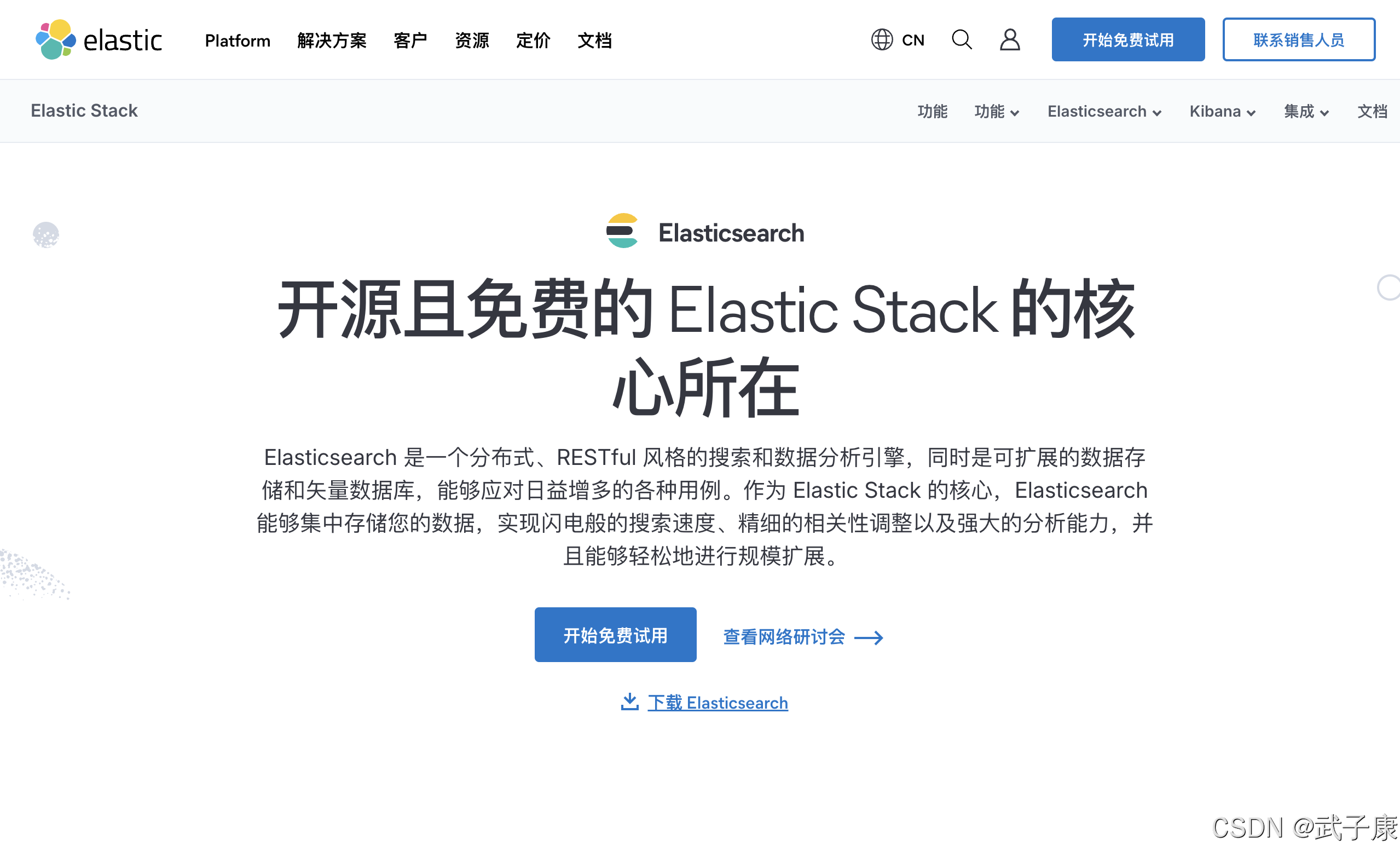
索引操作
创建索引:创建索引是存储数据的第一步。在 Elasticsearch 中,索引相当于关系数据库中的表。创建索引时,你可以指定映射(Mapping),定义字段类型(如 text、keyword、date、geo_point 等)。可以通过 Java API 传递索引设置(Settings)和映射来灵活定义索引的结构。
获取索引信息:通过 Java API 可以获取现有索引的详细信息,例如索引的元数据、字段映射、分片数量、副本数量等。这有助于用户分析和优化索引的性能。
索引存在性检查:在执行某些操作之前,检查索引是否存在是常见需求。例如,在插入数据前确保索引已经创建,或在删除索引之前确认它的存在性。
删除索引:删除不再需要的索引可以节省磁盘空间。需要小心的是,删除索引会清除该索引中的所有数据,操作不可逆,因此通常建议在执行此操作前进行备份。
更新索引设置:当集群扩展或数据增长时,你可能需要动态调整索引的分片数量或副本数量。Java API 提供了修改索引设置的功能,可以对现有索引进行优化调整。
文档操作
插入文档:文档是 Elasticsearch 中的最小数据存储单元,类似于关系数据库中的行。每个文档以 JSON 格式存储在索引中。通过 Java API,可以向特定索引插入单个文档,并指定文档的 ID(如果不指定,Elasticsearch 会自动生成一个 ID)。
获取文档:Java API 可以根据文档 ID 从索引中获取单个文档,返回的结果会包含文档的元数据信息,如 _id、_index、_version 等。获取文档操作通常用于精确查询和显示某个特定数据。
更新文档:更新文档时,Elasticsearch 并不会直接修改原始文档,而是通过创建一个新版本的文档来完成。Java API 支持部分更新(Partial Update),即只更新文档中的某些字段,而不必重新提交整个文档。
删除文档:删除文档同样基于文档 ID 进行操作。如果文档需要从集群中移除,可以通过 Java API 进行删除操作。此外,删除文档时也可以基于查询条件进行批量删除。
批量操作:在处理大量文档时,批量操作(Bulk API)非常重要。Java API 提供了批量插入、更新、删除文档的功能,可以提高大规模数据处理的效率。批量操作通常应用于数据迁移、批量更新、或者从其他系统同步数据到 Elasticsearch。
文件工程
IDEA新建Maven工程,开始对Elasticsearch的学习。
由于重复度很高,这里就跳过了,大家自行创建即可。
导入依赖
<?xml version="1.0" encoding="UTF-8"?><project xmlns="http://maven.apache.org/POM/4.0.0" xmlns:xsi="http://www.w3.org/2001/XMLSchema-instance" xsi:schemaLocation="http://maven.apache.org/POM/4.0.0 http://maven.apache.org/xsd/maven-4.0.0.xsd"> <modelVersion>4.0.0</modelVersion> <groupId>org.example</groupId> <artifactId>study-es</artifactId> <version>1.0-SNAPSHOT</version> <properties> <maven.compiler.source>17</maven.compiler.source> <maven.compiler.target>17</maven.compiler.target> <project.build.sourceEncoding>UTF-8</project.build.sourceEncoding> </properties> <dependencies> <dependency> <groupId>org.elasticsearch.client</groupId> <artifactId>elasticsearch-rest-high-level-client</artifactId> <version>7.3.0</version> <exclusions> <exclusion> <groupId>org.elasticsearch</groupId> <artifactId>elasticsearch</artifactId> </exclusion> </exclusions> </dependency> <dependency> <groupId>org.elasticsearch</groupId> <artifactId>elasticsearch</artifactId> <version>7.3.0</version> </dependency> <dependency> <groupId>junit</groupId> <artifactId>junit</artifactId> <version>4.12</version> <scope>compile</scope> </dependency> <dependency> <groupId>org.testng</groupId> <artifactId>testng</artifactId> <version>6.14.3</version> <scope>test</scope> </dependency> <dependency> <groupId>org.apache.logging.log4j</groupId> <artifactId>log4j-core</artifactId> <version>2.11.1</version> </dependency> </dependencies></project>配置文件
我们要在Resource目录下,新建 log4j2.xml
<?xml version="1.0" encoding="UTF-8"?><Configuration status="WARN"> <Appenders> <Console name="Console" target="SYSTEM_OUT"> <PatternLayout pattern="%d{yyyy-mm-dd HH:mm:ss} [%t] %-5p %c{1}:%L - %msg%n" /> </Console> </Appenders> <Loggers> <Root level="info"> <AppenderRef ref="Console" /> </Root> </Loggers></Configuration>创建Client
package icu.wzk;import org.apache.http.HttpHost;import org.elasticsearch.client.RestClient;import org.elasticsearch.client.RestClientBuilder;import org.elasticsearch.client.RestHighLevelClient;import org.junit.After;import org.junit.Before;import java.io.IOException;public class ElasticsearchTest { RestHighLevelClient client; @Before public void init() throws Exception { RestClientBuilder builder = RestClient.builder( new HttpHost("h121.wzk.icu", 9200, "http"), new HttpHost("h122.wzk.icu", 9200, "http"), new HttpHost("h123.wzk.icu", 9200, "http") ); final RestHighLevelClient highLevelClient = new RestHighLevelClient(builder); System.out.println(highLevelClient.cluster().toString()); client = highLevelClient; } @After public void destroy() throws IOException { if (null != client) { client.close(); } }}索引操作
创建索引
JSON方式
@Testpublic void createIndex() throws Exception { final CreateIndexRequest indexRequest = new CreateIndexRequest("wzk-icu-es-test"); // mapping 信息 // mapping 信息 String mapping = "{\n" + " \"settings\": {},\n" + " \"mappings\": {\n" + " \"properties\": {\n" + " \"description\": {\n" + " \"type\": \"text\",\n" + " \"analyzer\": \"ik_max_word\"\n" + " },\n" + " \"name\": {\n" + " \"type\": \"text\"\n" + " },\n" + " \"pic\": {\n" + " \"type\": \"text\",\n" + " \"index\": false\n" + " },\n" + " \"studymodel\": {\n" + " \"type\": \"text\"\n" + " }\n" + " }\n" + " }\n" + "}"; indexRequest.source(mapping, XContentType.JSON); // 创建索引 CreateIndexResponse indexResponse = client.indices().create(indexRequest, RequestOptions.DEFAULT); boolean acknowledged = indexResponse.isAcknowledged(); System.out.println("创建结果: " + acknowledged);}执行结果如下图所示,创建成功!
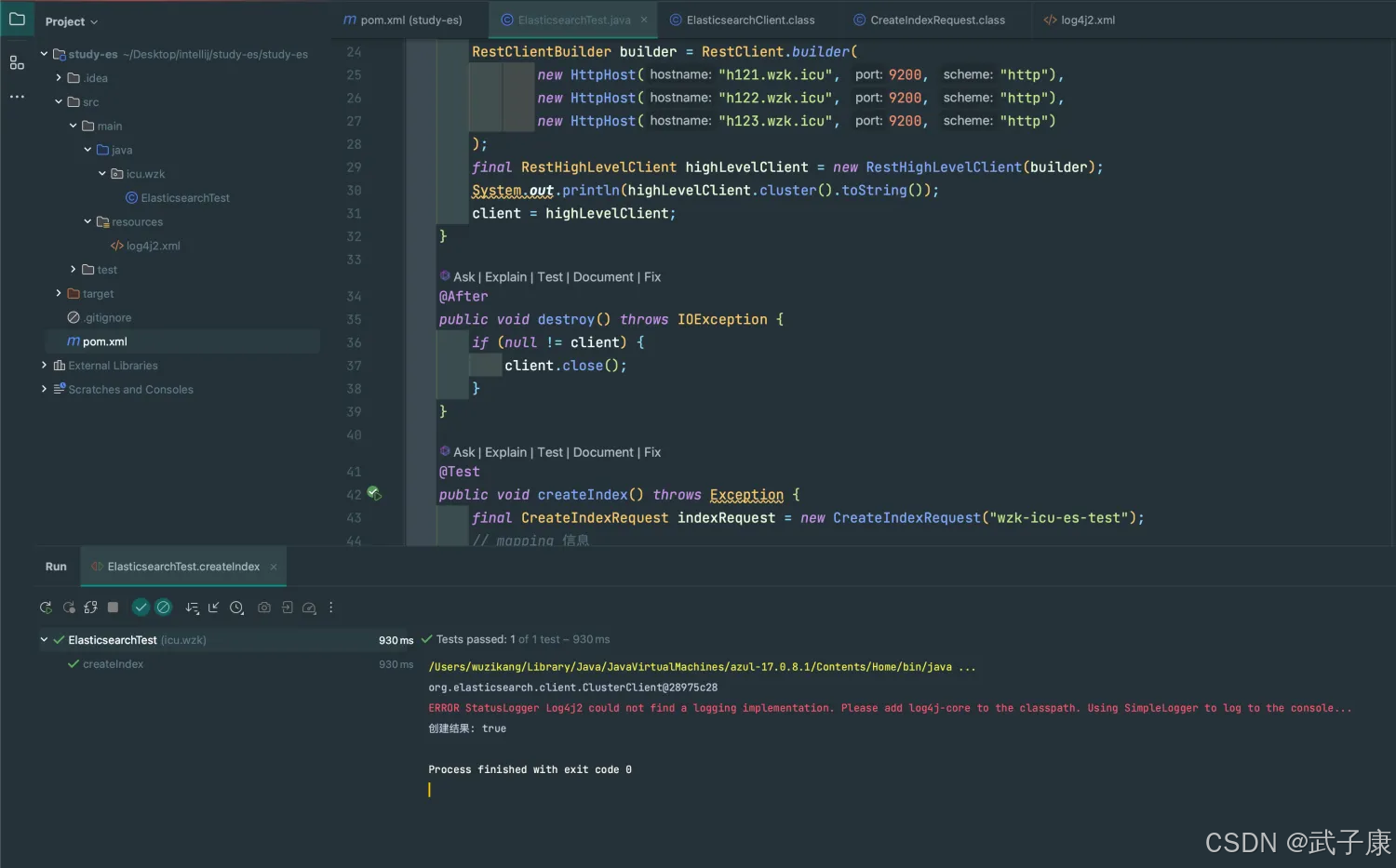
我们通过 Elasticsearch-Head 工具,可以看到如下的内容:

对象方式
@Testpublic void createIndex2() throws Exception { CreateIndexRequest createIndexRequest = new CreateIndexRequest("wzk-icu-es-2"); createIndexRequest.settings(Settings .builder() .put("index.number_of_shards", 5) .put("index.number_of_replicas", 1) .build()); // 指定 mapping XContentBuilder xContentBuilder = XContentFactory.jsonBuilder(); xContentBuilder.startObject(); xContentBuilder.startObject("properties"); xContentBuilder.startObject("description") .field("type", "text") .field("analyzer", "ik_max_word") .endObject(); xContentBuilder.startObject("name") .field("type", "text") .endObject(); xContentBuilder.startObject("pic") .field("type", "text") .field("index", "false") .endObject(); xContentBuilder.startObject("studymodel") .field("type", "text") .endObject(); xContentBuilder.endObject(); xContentBuilder.endObject(); // mapping塞进去 createIndexRequest.mapping(xContentBuilder); final CreateIndexResponse createIndexResponse = client .indices() .create(createIndexRequest, RequestOptions.DEFAULT); boolean acknowledged = createIndexResponse.isAcknowledged(); System.out.println("创建结果2: " + acknowledged);}执行的结果的如下图所示:
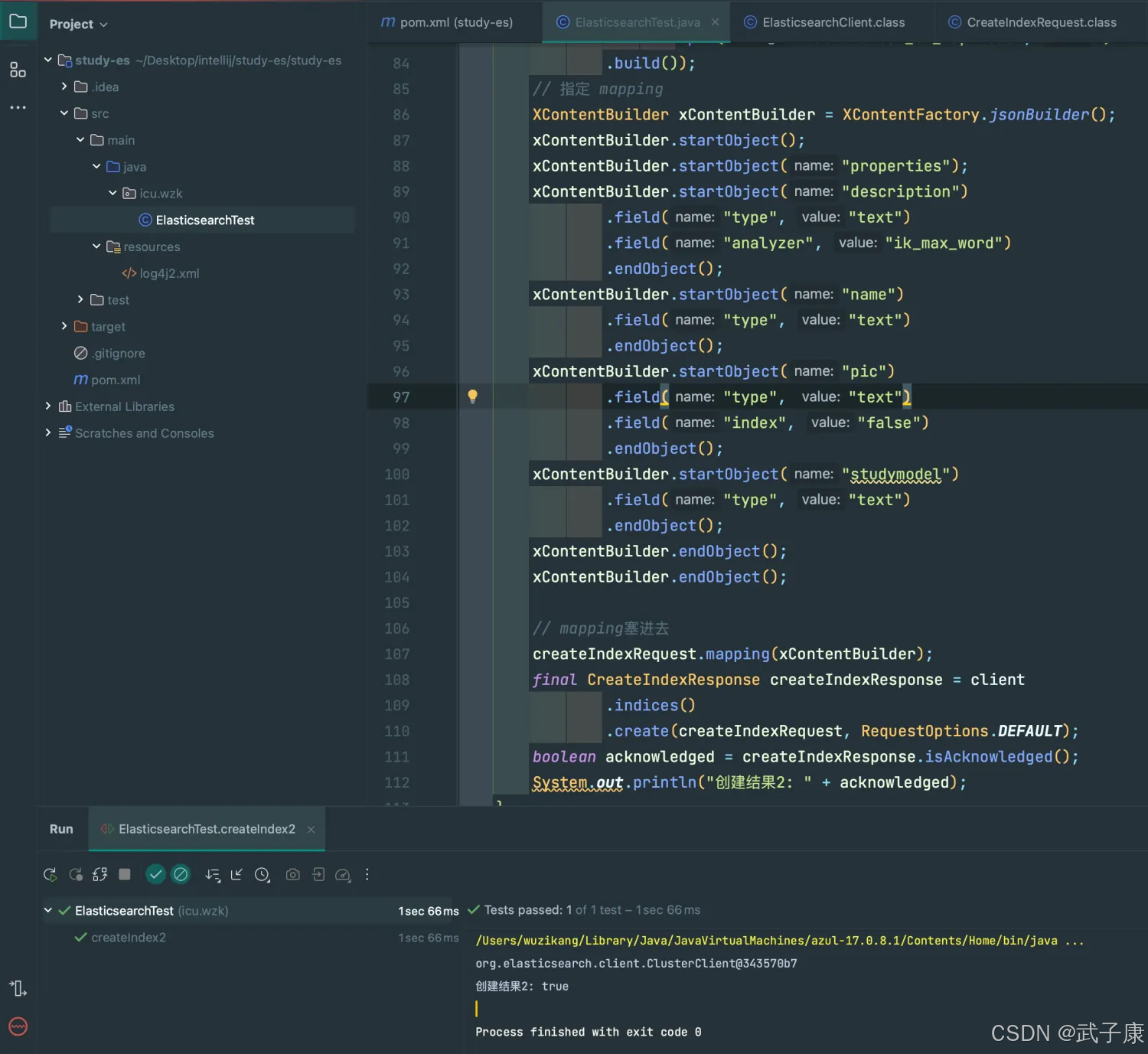
Elasticsearch-Head 查看,可以看到刚才创建的ES索引,分片的分布情况如下:
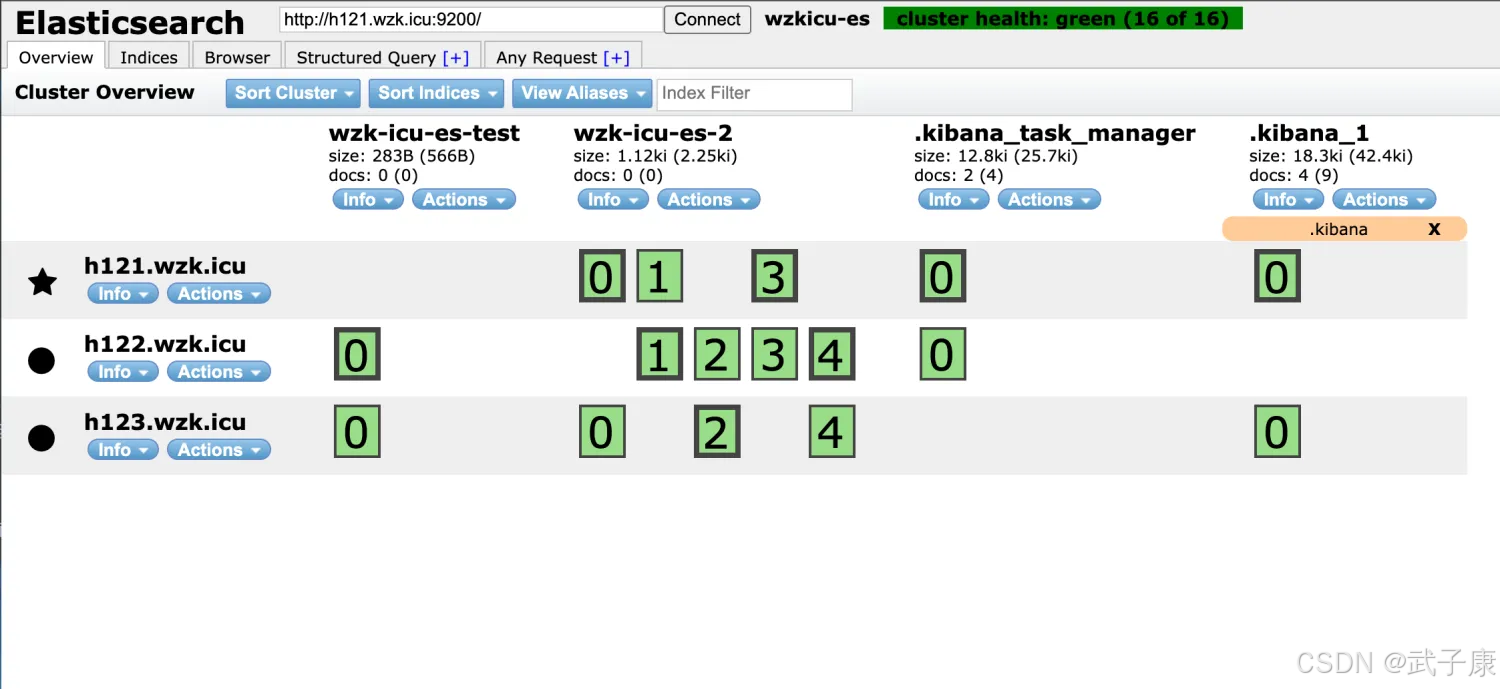
删除索引
@Testpublic void deleteIndex() throws Exception { DeleteIndexRequest deleteRequest = new DeleteIndexRequest("wzk-icu-es-test"); AcknowledgedResponse deleteResponse = client .indices() .delete(deleteRequest, RequestOptions.DEFAULT); boolean acknowledged = deleteResponse.isAcknowledged(); System.out.println("删除索引: " + acknowledged);}执行结果如下图所示:
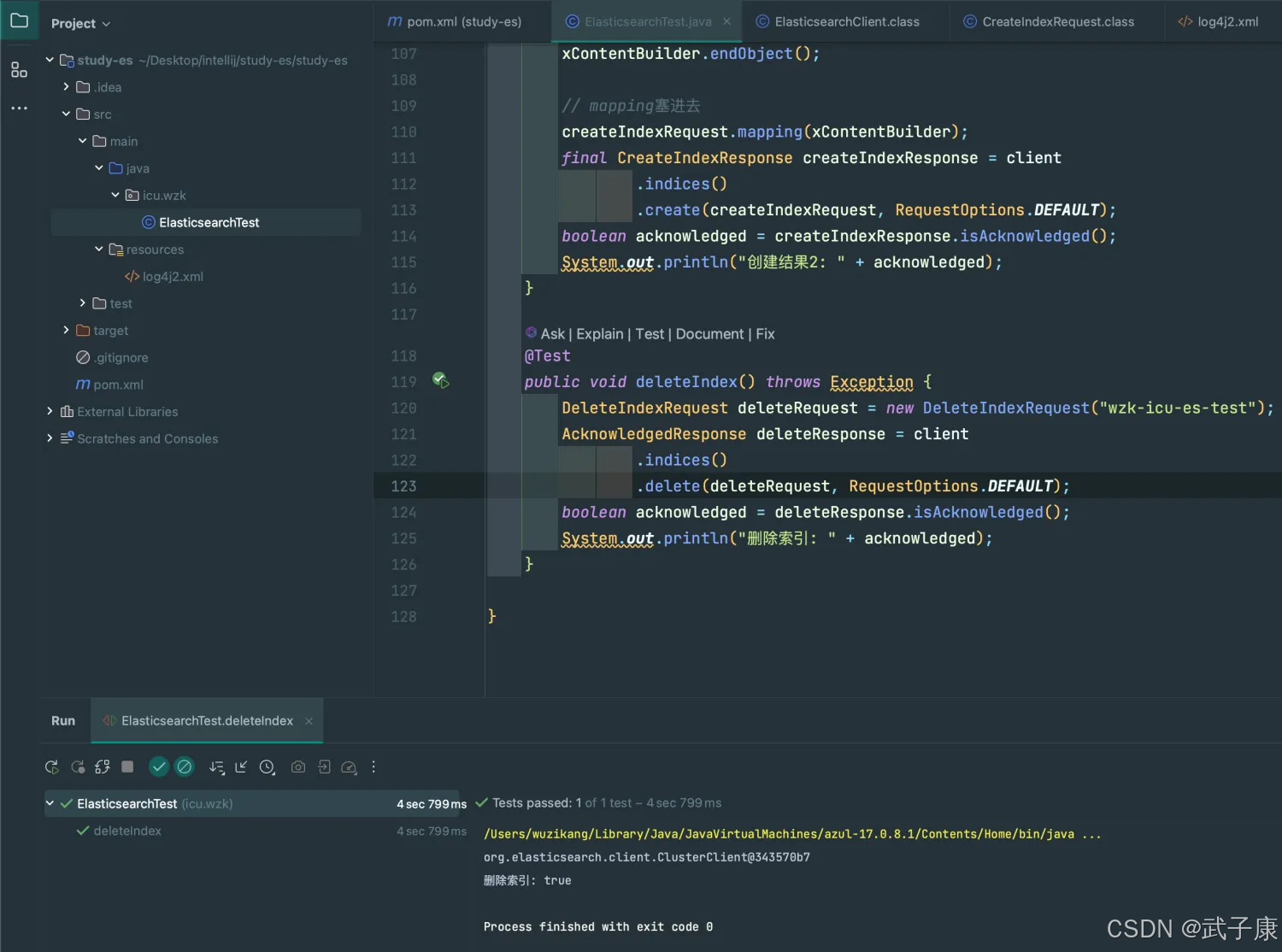
对应的Elasticsearch-Head查看,可以看到索引已经移除了:
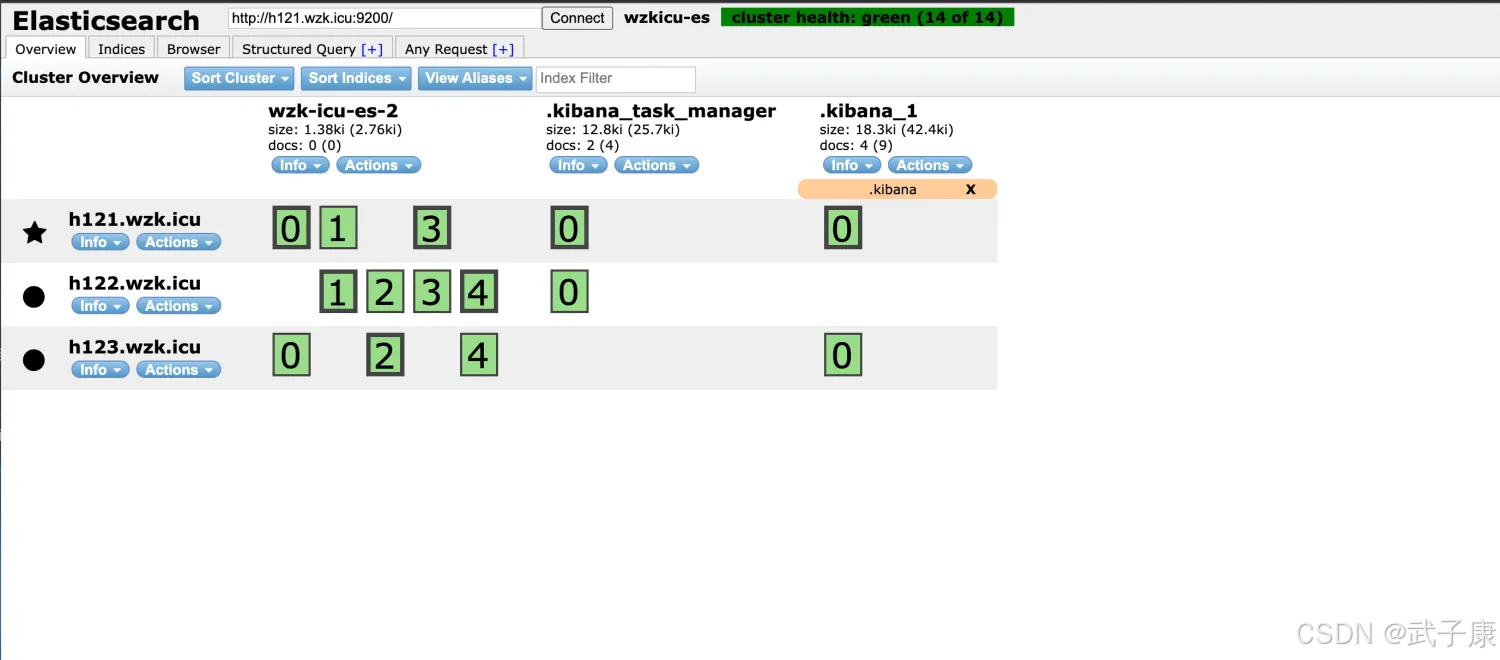
文档操作
添加文档
@Testpublic void addDoc() throws Exception { IndexRequest indexRequest = new IndexRequest("wzk-icu-es-2").id("1"); String str = " {\n" + " \"name\": \"spark添加文档\",\n" + " \"description\": \"spark技术栈\",\n" + " \"studymodel\":\"online\",\n" + " \"pic\": \"http://www.baidu.com\"\n" + " }"; indexRequest.source(str, XContentType.JSON); // 新增 IndexResponse index = client.index(indexRequest, RequestOptions.DEFAULT); System.out.println("新增的结果:" + index.status());}执行代码的结果如下图所示:
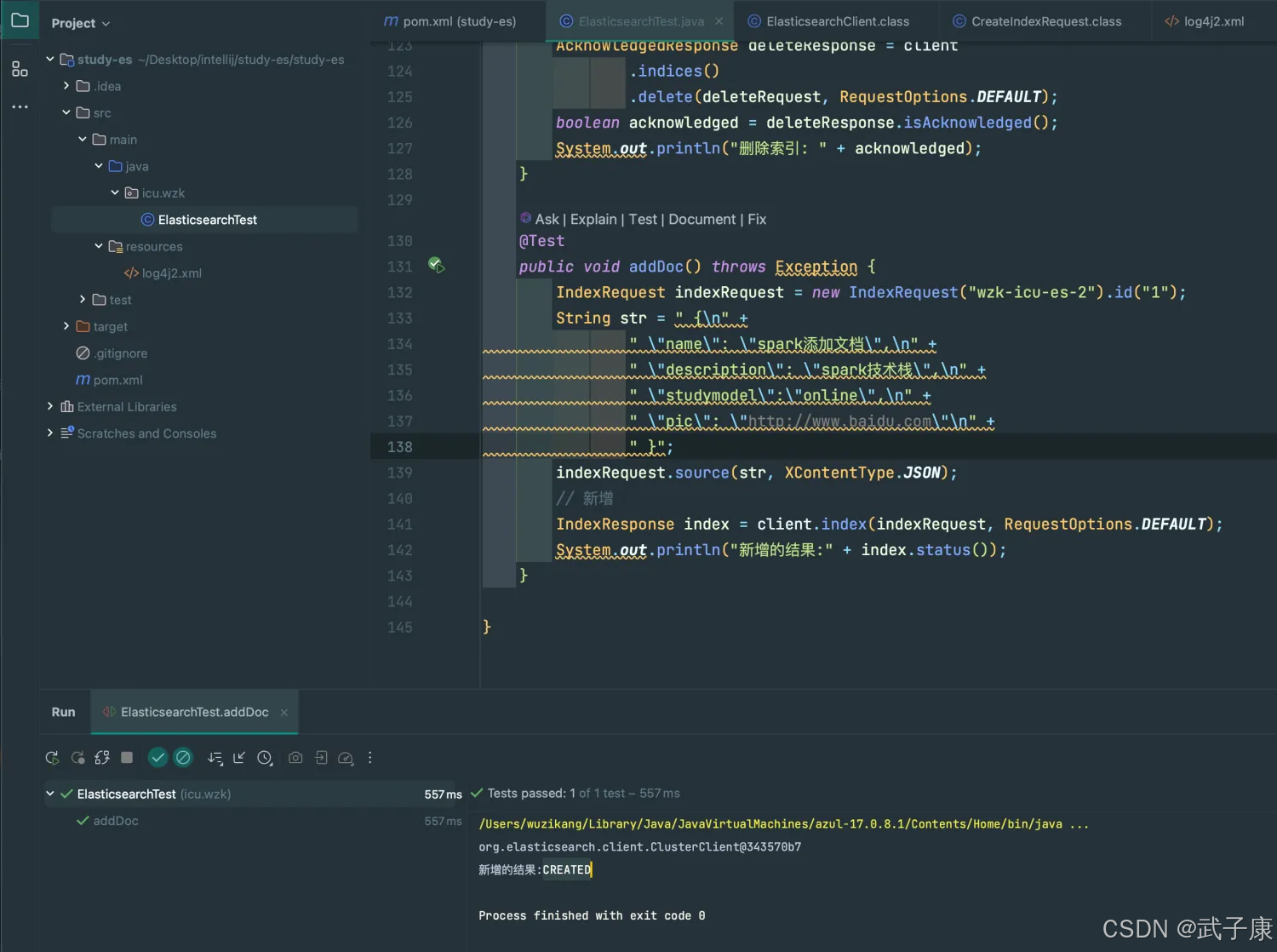
查询文档
@Testpublic void getDoc() throws Exception { GetRequest getRequest = new GetRequest("wzk-icu-es-2"); getRequest.id("1"); GetResponse getResponse = client.get(getRequest, RequestOptions.DEFAULT); Map<String, Object> sourceMap = getResponse.getSourceAsMap(); System.out.println("查询结果:" + sourceMap);}执行结果如下图:
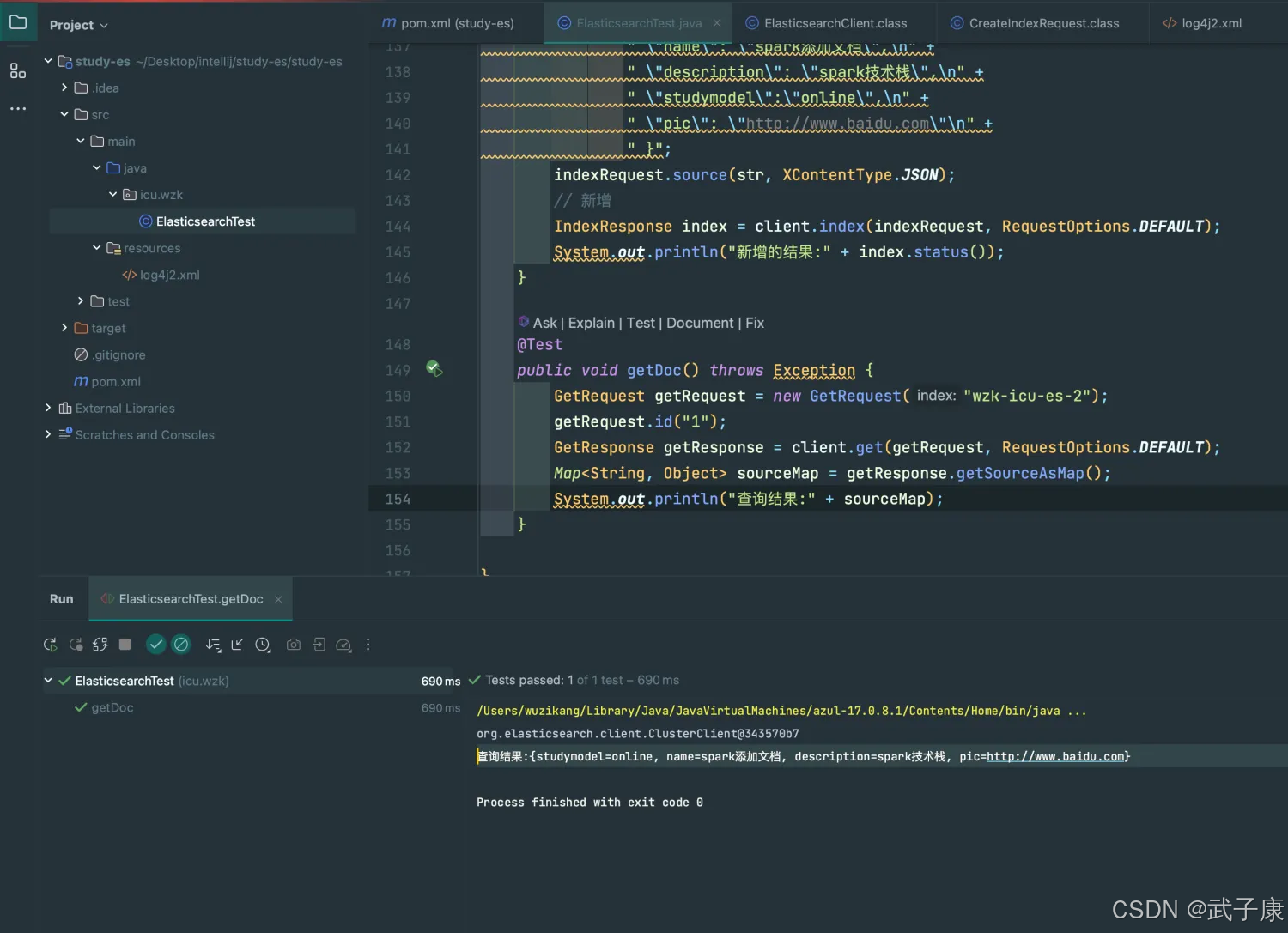
查询所有
@Testpublic void getAllDoc() throws Exception { SearchRequest searchRequest = new SearchRequest(); // 指定索引 searchRequest.indices("wzk-icu-es-2"); SearchSourceBuilder sourceBuilder = new SearchSourceBuilder(); sourceBuilder.query(QueryBuilders.matchAllQuery()); searchRequest.source(sourceBuilder); SearchResponse searchResponse = client.search(searchRequest, RequestOptions.DEFAULT); RestStatus status = searchResponse.status(); System.out.println("查询结果状态: " + status); SearchHits hits = searchResponse.getHits(); SearchHit[] hits1 = hits.getHits(); for (SearchHit sh : hits1) { System.out.println("---"); Map<String, Object> map = sh.getSourceAsMap(); System.out.println("查询的结果: " + map); }}执行的结果如下图所示:
